The Menhir as an Oral Tradition in Cattle-Raising Territories: First Geological Provenance Analyses at the Antequera Heritage Site, Spain
Abstract
1. Introduction
1.1. Menhirs in the Megalithic Landscape: State of the Art
1.2. Survey Area
2. Materials and Methods
2.1. Cattle Trails
2.2. Oral Sources
2.3. Written Sources
2.4. Intensive Field Surveying
2.5. Documentation of the Ground Milestones
2.6. Collection of Geological Samples
3. Results
3.1. Documented Menhirs
3.2. Menhirs and Quarries: Thin Section Samples Results
4. Discussion
Supplementary Materials
Author Contributions
Funding
Data Availability Statement
Acknowledgments
Conflicts of Interest
Abbreviations
| GIS | Geographic Information System |
| RTI | Reflectance Transformation imaging |
| OSL | Optically Stimulated Luminescence |
References
- Parker-Pearson, M. Archaeology and legend: Investigating Stonehenge. Archaeol. Int. 2021, 24, 144–164. [Google Scholar] [CrossRef]
- Sheridan, J.A.; Jones, A.M.; Pollard, J.; Allen, M.J.; Gardiner, J. Contextualising Kilmartin: Building a narrative for developments in western Scotland and beyond, from the Early Neolithic to the Late Bronze Age. In Image, Memory and Monumentality: Archaeological Engagements with the Material World; Meirion, A., Pollard, J., Allen, M.J., Gardiner, J., Eds.; Oxbow Books: Oxford, UK, 2012; pp. 163–183. [Google Scholar]
- Tramoni, P.; D’Anna, A.; Pasquet, A.; Milanini, J.L.; Chessa, R. Le site de Tivulaghju (Porto-Vecchio, Corse-du-Sud) et les coffres mégalithiques du Sud de la Corse, nouvelles données. Bull. De La Société Préhistorique Française 2007, 104, 245–274. [Google Scholar] [CrossRef]
- Cousseau, F. Bâtisseurs de Mégalithes: Un Savoir-Faire Néolithique Dévoilé par L’archéologie du Bâti; Archaeopress: Oxford, UK, 2023; p. 220. [Google Scholar]
- Curdy, P.; Ferroni, A.M.; Pizziolo, G.; Keller, R.P.; Sarti, L.; Baioni, M.; Marongiu, S. St-Martin-de-Corléans (Aosta, Italy) Tomb TII: The Chronological and Cultural Sequence. In The Bell Beaker Culture in All Its Forms, Proceedings of the 22nd Meeting of ‘Archéologie et Gobelets’, Geneva, Switzerland, 21–22 Janurary 2021; Abegg, C., Carloni, D., Cousseau, F., Derenne, E., Ryan, J., Eds.; Archaeopress Publishing Ltd.: Oxfordshire, UK, 2022; pp. 149–162. [Google Scholar]
- D’Anna, A.; Guendon, J.L.; Orsini, J.B.; Pinet, L.; Tramoni, P. Les alignements mégalithiques du plateau de Cauria (Sartene, Corse-du-Sud). In Corse et Sardaigne Préhistoriques: Relations et Échanges dans le Contexte Méditerranéen. Actes du 128e Congrès National des Sociétés Historiques et Scientifiques, Bastia, 2003; Comité des Travaux Historiques et Scientifiques: Paris, France, 2007; pp. 211–223. [Google Scholar]
- Linares-Catela, J.A.; Mora Molina, C.; López López, A.; Donaire Romero, T.; Vera-Rodríguez, J.C.; Bueno Ramírez, P. El sitio megalítico de La Torre-La Janera (Huelva): Monumentalidades prehistóricas del Bajo Guadiana. Trab. Prehist. 2022, 79, 115–130. [Google Scholar] [CrossRef]
- Rocha, L. O alinhamento da Têra, Pavia (Mora). Resultados da 1a Campanha (1996). In Muitas Antas, Pouca Gente?-Actas do I Colóquio Internacional sobre Megalitismo; Gonçalves, V., Catarina, A., Marques, A., Eds.; Instituto Português de Arqueologia: Reguengos de Monsaraz, Portugal, 2000; pp. 183–194. [Google Scholar]
- Skeates, R.; Beckett, J.; Mancini, D.; Cavazzuti, C.; Silvestri, L.; Hamilton, W.D.; Angle, M. Rethinking Collective Burial in Mediterranean Caves: Middle Bronze Age Grotta Regina Margherita, Central Italy. J. Field Archaeol. 2021, 46, 382–398. [Google Scholar] [CrossRef]
- Armitage, R.A.; Bueno-Ramírez, P.; Balbín-Behrmann, R.; Martineau, R.; Carrera-Ramírez, F.; Fairchild, T.; Southon, J. Charcoal painted images from the French Neolithic Villevenard hypogea: An experimental protocol for radiocarbon dating of conserved and in situ carbon with consolidant contamination. Archaeol. Anthr. Sci. 2020, 12, 123. [Google Scholar] [CrossRef]
- Barroso Bermejo, R.; Bueno Ramírez, P.; de Balbín Behrmann, R. Megaliths Weapons representations: Aview of the birth of the Iberia warrior images. In Weapons Tools in Rock Art Aworld, Perspective; Bettencourt, A.M.S., Santos-Estévez, M., Sampaio, H.A., Eds.; Oxbow Books: Oxford, UK, 2021; pp. 87–102. [Google Scholar]
- Bueno Ramírez, P.; de Balbin Behrmann, R.; Barroso Bermejo, R. Chronologie de l’art Mégalithique ibérique: C14 et contextes archéologiques. L’Anthropologie 2007, 111, 590–654. [Google Scholar] [CrossRef]
- Bueno Ramírez, P.; de Balbin Behrmann, R.; Laporte, L.; Gouézin, P.; Cousseau, F.; Barroso, R.; Hernanz, A.; Iriarte, M.; Quesnel, L. Natural and artificial colours: The megalithic monuments of Brittany. Antiquity 2015, 89, 55–71. [Google Scholar] [CrossRef]
- Bueno Ramírez, P.; Barroso Bermejo, R.; de Balbín Behrmann, R. Megalithic art: Funeral scenarios in western Neolithic Europe. In The Megaliths of the World; Laporte, L., Large, J.M., Nespoulous, L., Scarre, C., Steimer-herbet, T., Eds.; Archaeopress: Oxford, UK, 2022. [Google Scholar]
- Bueno Ramírez, P.; Barroso Bermejo, R.; de Balbín Behrmann, R. Pigments for the dead: Megalithic scenarios in southern Europe. Archaeol. Anthropol. Sci. 2023, 15, 148. [Google Scholar] [CrossRef]
- Carrera Ramírez, F.; Fábregas Valcarce, R. Datación radiocarbónica de pinturas megalíticas del Noroeste peninsular. Trab. Prehist. 2002, 59, 157–166. [Google Scholar] [CrossRef]
- Steelman, K.L.; Carrera Ramírez, F.; Fábregas Valcarce, R.; Guilderson, T.; Rowe, M.W. Direct radiocarbon dating of megalithic paints from north-west Iberia. Antiquity 2005, 79, 379–389. [Google Scholar] [CrossRef]
- Bueno Ramírez, P.; Soler Diaz, J.A. Construyendo identidades. Figuritas, estelas y menhires en el suroccidente de Iberia. In Ídolos. Miradas Milenarias Desde el Extremo Suroccidental de Europa; Bueno, P., Soler, J.A., Eds.; Junta de Andalucía, Consejería de Turismo, Cultura y Deporte: Huelva, Spain, 2024; pp. 31–52. [Google Scholar]
- Bueno Ramírez, P.; Linares Catela, J.A.; de Balbín Behrmann, R.; Barroso, R. Símbolos de la muerte en la Prehistoria Reciente del Sur de Europa. El dolmen de Soto, Huelva. España, Reed. 2024; Arqueología Monografías; Junta de Andalucía: Seville, Spain, 2018. [Google Scholar]
- Bueno Ramírez, P.; Barroso Bermejo, R.; de Balbín Behrmann, R. Reconstruyendo Memorias megalíticas (REMEM). In Actualidad de la Investigación Arqueológica en España (2021–2022), Conferencias Impartidas en el Museo Arqueológico Nacional; Ministerio de Cultura y Deporte, Secretaría General Técnica, Subdirección General de Atención al Ciudadano, Documentación y Publicaciones, Ed.; Ministerio de Cultura y Deporte, Secretaría General Técnica, Subdirección General de Atención al Ciudadano, Documentación y Publicaciones: Madrid, Spain, 2022; pp. 149–164. [Google Scholar]
- Laporte, L.; Cousseau, F.; Ramírez, B.; de Balbín Behrmann, R.; Gouézin, P. Le douzième dolmen de Barnenez: Destructions et reconstructions au sein d’une nécropole mégalithique. Bull. De La Société Préhistorique Française 2017, 114, 93–114. [Google Scholar] [CrossRef]
- Madgwick, R.; Lamb, A.L.; Sloane, H.; Nederbragt, A.J.; Albarella, U.; Pearson, M.P.; Evans, J.A. Multi-isotope analysis reveals that feasts in the Stonehenge environs and across Wessex drew people and animals from throughout Britain. Sci. Adv. 2019, 5, eaau6078. [Google Scholar] [CrossRef] [PubMed]
- Robin, G. Art and death in late Neolithic Sardinia: The role of carvings and paintings in Domus de Janas rock-cut tombs. Camb. Archaeol. J. 2016, 26, 429–469. [Google Scholar] [CrossRef]
- Williams, K. Megalithic art on the Great Circle at Newgrange and the implications for chronology. J. Ir. Archaeol. 2023, 32, 1. [Google Scholar]
- Van Dyke, R.M.; Alcock, S.E. Archaeologies of Memory: An Introduction; Blackwell: Oxford, UK, 2003. [Google Scholar]
- Bueno Ramírez, P.; de Balbín Behrmann, R.; Barroso Bermejo, R. Análisis de las grafías megalíticas de los dólmenes de Antequera y su entorno. In Dólmenes de Antequera. Tutela y Valorización Hoy; Ruiz González, B., Ed.; Junta de Andalucía: Sevilla, Spain, 2009; pp. 186–197. [Google Scholar]
- Bueno Ramírez, P.; de Balbín Behrmann, R.; Gutiérrez López, J.M.; Enriquez Jarén, L. Hitos visibles del megalitismo gaditano. In Homenaje a Francisco Giles Pacheco; Mata, E., Ed.; Diputación Provincial de Cádiz, Servicio de Publicaciones, Asociación Profesional del Patrimonio Histórico-Arqueológico de Cádiz: Cádiz, Spain, 2010; pp. 209–228. [Google Scholar]
- Bueno Ramírez, P.; de Balbín Behrmann, R.; Barroso Bermejo, R.; Carrera Ramírez, F.; Ayora Ibáñez, C. Secuencias de arquitecturas y símbolos en el dolmen de Viera (Antequera, Málaga, España). MENGA Rev. De Prehist. De Andal. 2013, 4, 251–266. [Google Scholar]
- Bueno Ramírez, P.; de Balbín Behrmann, R.; Barroso Bermejo, R.M.; Carrera Ramírez, F.; Huntz Ortiz, M.A.H. El arte y la plástica en el tholos de Montelirio. In Montelirio: Un Gran Monumento Megalítico de la Edad del Cobre; Fernández Flores, A., García Sanjuán, L., Díaz-Zorita Bonilla, M., Eds.; Consejería de Cultura: Sevilla, Spain, 2016; pp. 365–405. [Google Scholar]
- Bueno Ramírez, P.; de Balbín Behrmann, R. Estelas Decoradas en los Megalitos del País Vasco. Megalitos, Espacios Sagrados y Referentes Territoriales; Museo de Bilbao: Zegama, Spain, 2023; pp. 266–289. [Google Scholar]
- Mora Molina, C. Los Monumentos Megalíticos de Antequera (Málaga): Una Propuesta Biográfica; Consejería de Cultura y Deporte, Junta de Andalucía: Sevilla, Spain, 2024.
- Rogerio-Candelera, M.Á.; Bueno Ramírez, P.; De Balbín-Behrmann, R.; Dias, M.I.; García Sanjuán, L.; Coutinho, M.L.; Gaspar, D. Landmark of the past in the Antequera megalithic landscape: A multi-disciplinary approach to the Matacabras rock art shelter. J. Archaeol. Sci. 2018, 95, 76–93. [Google Scholar] [CrossRef]
- Laporte, L. Megalithic architectures in Europe—A southern point of view. In Megalithic Architectures; Laporte, L., Scarre, C., Eds.; Oxbow Monographs: Oxford, UK, 2016; pp. 227–234. [Google Scholar]
- L’Helgouach, J. Les idols qu’on abat. Bull. De La. Société Polymath. Du. Morbihan 1983, 110, 57–68. [Google Scholar]
- Ard, V.; Mens, E.; Poncet, D.; Cousseau, F.; Dehaix, J.; Mathé, V.; Pillot, L. Life and death of angoumoisin-type dolmens in west-central France: Architecture and evidence of the reuse of megalithic orthostats. Bull. De La Société Préhistorique Française 2016, 113–114, 737–764. [Google Scholar] [CrossRef]
- Ard, V.; Mens, E.; Bueno Ramírez, P.; de Balbín Behrmann, R.; Gouézin, P.H.; Laurent, A.; Linard, D.; Marquebielle, B.; Philippe-Lelong, A.C.; Polloni, A.; et al. The Roquefort Megalithic Monument at Lugasson (Gironde) and the Question of Gallery Graves in Aquitaine. Gall. Préhistoire 2024, 64. [Google Scholar] [CrossRef]
- Harrison, R.; Heyd, V. The Transformation of Europe in the Third Millennium BC: The example of Le Petit-Chasseur I + III (Sion, Valais, Switzerland). Praehist. Z. 2007, 82, 129–214. [Google Scholar] [CrossRef]
- Robb, J. People of stone: Stelae, personhood, and society in prehistoric Europe. J. Archaeol. Method. Theory 2009, 16, 162–183. [Google Scholar] [CrossRef]
- Migdley, M. Megaliths in north-west Europe. The cosmology of sacred landscapes. In The Oxford Handbook of the Archaeology of Death and Burial; Tarlow, S., Nilsson Stutz, L., Eds.; Oxford University Press: Oxford, UK, 2013; pp. 421–440. [Google Scholar]
- Scarre, C. Atlantic figurines. In Mobile Images of Ancestral Bodies: A Millenium Long-Perspective from Iberia to Europe; Bueno Ramírez, P., Soler Diaz, J.A., Eds.; Zona Arqueológica: Alcalá de Henares, Spain, 2021; Volume II, pp. 239–252. [Google Scholar]
- Spatzier, A.; Bertemes, F. The ring sanctuary of Pömmelte, Germany: A monumental, multi-layered metaphor of the late third millennium BC. Antiquity 2018, 92, 655–673. [Google Scholar] [CrossRef]
- Schultz Paulsson, B.S. Radiocarbon dates and Bayesian modeling support maritime diffusion model for megaliths in Europe. Proc. Natl. Acad. Sci. USA 2019, 116, 3460–3465. [Google Scholar] [CrossRef] [PubMed]
- Laporte, L.; Bueno Ramírez, P. On the Atlantic shores. The origins of megaliths in Europe? In Mégaliths of the World; Laporte, L., Large, J.-M., Nespoulous, L., Scarre, C., Herbet-Steimer, T., Eds.; Archaeopress: Oxford, UK, 2022; pp. 1173–1192. [Google Scholar]
- Bueno Ramírez, P.; de Balbín Behrmann, R.; Barroso Bermejo, R.; López Quintana, J.C.; Guenaga Lizasu, A. Frontières et art mégalithique. Une perspective depuis le monde pyrenéen. L’Anthropologie 2009, 113, 882–929. [Google Scholar] [CrossRef]
- Bueno Ramirez, P.; Barroso Bermejo, R.; Balbin Behrmann, R. Megalithic paintings: Absence or mislead research? Andalucia as a South European case study. In Pierre à Bâtir, Pierre à Penser. Systèmes Techniques et Productions Symboliques des Pré et Protohistoire Méridionales; Archives d’Ecologie Préhistorique: Toulouse, France, 2023; Volume 13, Available online: https://univ-tlse2.hal.science/hal-04259814/ (accessed on 16 July 2025).
- Peñalver, X. Estudio de los menhires de Euskal Herria. Munibe 1983, 35, 355–450. [Google Scholar]
- Villalobos García, R.; Moreno Gallo, M.; Basconcillos Arce, J.; Delibes de Castro, G. Menhires prehistóricos en el sector nororiental de la meseta norte española: Análisis espacial concerniente a la hipótesis de una alineación estructurada y sincrónica. In Arqueología y Tecnologías de Información Espacial: Una Perspectiva Ibero-Americana; Maximiano Castillejo, A.M., Cerrillo Cuenca, E., Eds.; Archaeopress: Oxford, UK, 2015; pp. 253–264. [Google Scholar]
- Bueno Ramírez, P.; de Balbín Behrmann, R.; Barroso Bermejo, R. Custodian stones: Human Images in the Megalithism of the Southern Iberian Peninsula. In Rendering Death: Ideological and Archaeological Narratives from Recent Prehistory (Iberia); Cruz, A., Cerrillo, E., Bueno, P., Caninas, J., Batata, C., Eds.; British Archaeological Reports. International Series 2648; Archaeopress: Oxford, UK, 2014; pp. 3–12. [Google Scholar]
- Bueno Ramírez, P.; Barroso Bermejo, R.; Balbin Behrmann, R. Steles, Time and Ancestors in the Megaliths of Antequera, Málaga (Spain). Menga 2017, 8, 193–219. [Google Scholar]
- Cámara Serrano, J.A.; Dorado Alejos, A.; Spanedda, L.; Fernández Ruiz, M.; Martínez García, J.; Haro Navarro, M.; Molina González, F. La demarcación de los espacios de tránsito en Los Millares (Santa Fe de Mondújar, Almería) y su relación con el simbolismo megalítico. Zephyrus 2021, 88, 65–86. [Google Scholar] [CrossRef]
- Bailiff, I.K.; Andrieux, E.; Díaz-Guardamino, M.; Alves, L.B.; Rey, B.C.; Sanjuán, L.G.; Seijo, M.M. Dating the setting of a late prehistoric statue-menhir at Cruz de Cepos, NE Portugal. Quat. Geochronol. 2024, 83, 101569. [Google Scholar] [CrossRef]
- Bueno Ramírez, P.; de Balbín Behrmann, R.; González Cordero, A. El arte megalítico como evidencia de culto a los antepasados: A propósito del dolmen de La Coraja (Cáceres). Quad. De Prehistòria I Arqueol. De Castelló 2001, 47–72. [Google Scholar]
- Bueno Ramírez, P.; Barroso Bermejo, R.; Balbin Behrmann, R. Stone witnesses: Armed stelae between the international Tagus and the Douro, Iberian Peninsula. SPAL Rev. De Prehist. Y Arqueol. De La Univ. De Sevilla 2019, 28, 143–164. [Google Scholar] [CrossRef]
- Cerrillo-Cuenca, E.; Bueno-Ramírez, P.; de Balbin-Behrmann, R. 3DMeshTracings: A protocol for the digital recording of prehistoric art. Its application at Almendres cromlech (Évora, Portugal). J. Archaeol. Sci. Rep. 2019, 25, 171–183. [Google Scholar] [CrossRef]
- Filipe, V.; Godinho, R.; Granja, R.; Valera, A.C. Espacios funerarios de la Edad del Bronce en Outeiro Alto 2 (Brinches, Serpa, Portugal): La necrópolis de hipogeos. Zephyrus 2013, LXXI, 107–129. [Google Scholar]
- Moreno Gallo, M.Á.; Delibes de Castro, G. Dataciones absolutas para un menhir del valle de Valdelucio (Burgos): Resultados de un sondeo en el túmulo de La Cuesta del Molino. Zephyrvs 2007, 60, 173–179. [Google Scholar]
- Valera, A.C.; Coelho, M. A necrópole de hipogeus da Sobreira da Cima (Vidigueira, Beja): Enquadramento, arquitecturas e contextos. Era Monográfica 2013, 1, 11–40. [Google Scholar]
- Cassen, S. Exercice de Stèle: Une Archéologie des Pierres Dressées, Réflexion Autour des Menhirs de Carnac; Errance: Paris, France, 2009. [Google Scholar]
- Calado, M. Standing stones and natural outcrops. The role of ritual monuments in the Neolithic transition of the Central Alentejo. In Monuments and Landscape in Atlantic Europe Perception and Society During the Neolithic and Early Bronze Age; Scarre, C., Ed.; Routledge: London, UK; New York, NY, USA, 2002; pp. 17–35. [Google Scholar]
- Gomes, M.V.; Monteirio, J.P.; Serrâo, J.C. A estação pré-histórica da Caramujeira. Trabalhos de 1975–76. In III Jornadas Arqueológicas; AAP: Lisboa, Portugal, 1978; Volume I, pp. 33–72. [Google Scholar]
- Gomes, M.V. Betilos, estelas e menires no Neolítico do Extremo Suroeste peninsular. In Idolos. Miradas Milenarias Desde el Extremo Suroccidental de Europa; Bueno, P., Soler, J.A., Eds.; Junta de Andalucía, Consejería de Turismo, Cultura y Deporte: Huelva, Spain, 2024; pp. 121–142. [Google Scholar]
- Breuil, H.; Verner, W. Découverte de deux Centres Dolméniques sur les bords de la Laguna de la Janda. (Cadix). Bulletin Hispanique; Annales de la Faculté des Lettres de Bordeaux et des Universités de Midi: Bordeaux, France, 1917; Volume XIX, pp. 157–188. [Google Scholar]
- Berdichewsky, B. Los Enterramientos en Cuevas Artificiales del Bronce I Hispánico; Biblioteca Praehistorica Hispana VI: Madrid, Spain, 1964. [Google Scholar]
- Marqués-Merelo, I.; Aguado-Mancha, T.; Márquez-Romero, J.E. (Eds.) Necrópolis Prehistórica de Sepulcros Excavados en roca en el Cortijo de Alcaide (Antequera, Málaga); Universidad de Málaga: Málaga, Spain, 2024. [Google Scholar]
- Bueno Ramírez, P.; Balbin Behrmann, R.; de Barroso Bermejo, R. Dioses y antepasados que salen de las piedras. Patrimonio Megalítico: Más allá de los límites de la Prehistoria. PH Boletín Del Inst. Andal. Del Patrim. Histórico 2008, 67, 62–67. [Google Scholar]
- García Sanjuán, L.; Wheatley, D.W.; Lozano Rodríguez, J.A.; Evangelista, L.S.; González García, A.C.; Cintas-Peña, M.; Rivera Jiménez, T. In the bosom of the Earth: A new megalithic monument at the Antequera World Heritage Site. Antiquity 2023, 97, 576–595. [Google Scholar] [CrossRef]
- Bueno Ramírez, P.; de Balbín Behrmann, R.; Barroso Bermejo, R. Símbolos para los muertos, símbolos para los vivos. Arte megalítico en Andalucía. In Actas del II Congreso de Arte Rupestre Esquemático en la Península Ibérica; Martínez, J., Hernández, M.S., Eds.; Ayuntamiento de Vélez-Blanco: Almería, Spain, 2013; pp. 25–47. [Google Scholar]
- Camalich Massieu, M.D.; Martin Socas, D. Los inicios del neolítico en Andalucía. Entre la tradición y la innovación. Rev. Menga 2013, 4, 103–129. [Google Scholar]
- Cantalejo Duarte, P.; Espejo Herrerías, M. Málaga en el Origen del arte Prehistórico Europeo; Pinsapar, Ed.; Guía de las cuevas prehistóricas malagueñas; Diputación de Málaga: Málaga, Spain, 2014. [Google Scholar]
- Aranda Jiménez, G.; García Sanjuán, L.G.; Lozano Medina, A.; Costa Caramé, M.E. Nuevas dataciones radiométricas del dolmen de Viera (Antequera, Málaga, España). Menga Rev. De Prehist. De Andal. 2013, 235–251. [Google Scholar]
- Diaz-Zorita Bonilla, M.; García Sanjuán, L. Las inhumaciones medievales del atrio del dolmen de Menga (Antequera, Málaga): Estudio antropológico y cronología absoluta. Menga Rev. De Prehist. De Andal. 2012, 237–249. [Google Scholar]
- Tovar Fernandez, A.; Marques Merelo, I.; Jimenez Brobeil, S.A.; Aguado Mancha, T.; Fernández, A.T. El hipogeo número 14 de la necrópolis de Alcaide (Antequera, Málaga): Un enterramiento colectivo de la Edad del Bronce. Menga Rev. De Prehist. De Andal. 2014, 123–149. [Google Scholar]
- Aranda Jiménez, G.; Sanchez Romero, M.; Diaz-Zorita Bonilla, M.; Lozano Medina, A.; Escudero Carrillo, J.; Milesi, L. Cultural resistance to social fragmentation: The continuity and reuse of megalithic monuments during the Argaric Bronze Age in southeastern Iberia. In The Matter of Prehistory: Papers in Honor of Antonio Gilman Guillén; Díaz, P., Lilios, K., Sastre, I., Eds.; Consejo Superior de Investigaciones Científicas, CSIC: Madrid, Spain, 2020; pp. 213–233. [Google Scholar]
- Lorrio, A.J.; Montero Ruiz, I.M. Reutilización de sepulcros colectivos en el Sureste de la Península Ibérica: La colección Siret. Trab. De Prehist. 2004, 61, 99–116. [Google Scholar] [CrossRef]
- Milesi García, L.; Aranda Jiménez, G.; Bonilla, M.D.-Z.; Ruiz Carrasco, S.; Hamilton, D.; Vilches Suárez, M.; Becerra Fuello, P. Funerary practices in megalithic tombs during the argaric Bronze Age in South-Eastern Iberia: The cemetery of los Eriales. J. Archaeol. Sci. Rep. 2023, 49, 103972. [Google Scholar] [CrossRef]
- Suárez Padilla, J.; Álvarez Martín-Aguilar, M.; Mora Serrano, B.; Machuca Prieto, F.; Caro Herrero, J.L.; López Chamizo, S.; Schloen, D.; López-Rúiz, C.; Sáenz Romero, A.; Ramírez Cañas, C.; et al. Novedades en la investigación arqueológica en el yacimiento fenicio del Cerro del Villar, Málaga (2021–2022). In Entre Málaga y Tiro una Travesía Mediterránea en Memoria de la Profesora María Eugenia Aubet Semmler; Núñez, F.J., Mederos, A., Suárez, J., Mora, B., Martín, E., Eds.; Anejos de la revista Mainake; CEDMA: Málaga, Spain, 2025; pp. 13–28. [Google Scholar]
- Atencia Páez, R.; Serrano Ramos, E. Las comunicaciones de Antequera en época romana. Jábega 1980, 31, 15–20. [Google Scholar]
- Gozalbes Cravioto, C.G. El Camino Real de Málaga a Antequera en el siglo XVIII. Jábega 1981, 55–61. [Google Scholar]
- Vera, J.A.; Martín-Algarra, A. Cordillera Bética y Baleares. In Geología de España; Vera, J.A., Ed.; Sociedad Geológica de España-IGME: Madrid, Spain, 2004; pp. 45–464. [Google Scholar]
- Carrasco, F.; Andreo, B.; Linares, L.; Sánchez, D.; Rendón, M.; Cobos, A.; Ortega, F.; Vadillo, I.; Pérez, I. Contexto hidrogeológico de humedales del Norte de la provincia de Málaga. In VI Simposio del Agua en Andalucía; López-Geta, J.A., Rubio, J.C., Martín Machuca, M., Eds.; IGME: Madrid, Spain, 2005; pp. 605–618. [Google Scholar]
- Dutfield, G. Protecting Traditional knowledge: Pathways to the Future; International Centre for Trade and Sustainable Development (ICTSD): Geneva, Switzerland, 2006. [Google Scholar]
- Liu, B.; Wu, C.; Xu, W.; Shen, Y.; Tang, F. Emerging trends in GIS application on cultural heritage conservation: A review. Herit. Sci. 2024, 12, 139. [Google Scholar] [CrossRef]
- Carvalho, A.F.; Tente, C. Orlando Ribeiro’s work on trashumant pastoralism in north-central Portugal: Guidelines for a research project on etno-history and archaeology. Hist. Agrar. 2023, 89, 1–29. [Google Scholar]
- Harrison, R.J. The ‘Policultivo Ganadero’, or the Secondary Products Revolution in Spanish Agriculture, 5000–1000 Bc. Proc. Prehist. Soc. 1985, 51, 75–102. [Google Scholar] [CrossRef]
- Fairén-Jiménez, S.; Cruz Berrocal, M.; López-Romero González, E.; Sbeinati, S.W. Las vías pecuarias como elementos arqueológicos. La Apl. De Los. SIG En. La Arqueol. Del Paisaje 2006, 55–68. [Google Scholar]
- Montes, L.; Sebastián, M.; Domingo, R.; Beguería, S.; García-Ruiz, J.M. Spatial distribution of megalithic monuments in the subalpine belt of the Pyrenees: Interpretation and implications for understanding early landscape transformation. J. Archaeol. Sci. Rep. 2020, 33, 102489. [Google Scholar] [CrossRef]
- Mataloto, R.; Cardoso, J. As antas, marcadores simbólicos das paisagems e dos territorios medievais. In Estudos de Homenagem a MªJosé Ferro Tavares; Cardoso, J.L., Candeias, J., Avelar, A.P., Eds.; Universidade Oberta: Lisboa, Portugal, 2024; pp. 35–42. [Google Scholar]
- Martinón-Torres, M. Los Megalitos de término. Crónica del valor territorial de los monumentos megalíticos a partir de las fuentes escritas. Trab. De Prehist. 2001, 58, 95–108. [Google Scholar] [CrossRef]
- Aranda Jiménez, G.; García Sanjuán, L.; Mora Molina, C.; Moreno Escobar, M.C.; Rodríguez Cantal, J.; Robles Carrasco, S.; Vázquez Paz, J. Evidencias de asentamiento y prácticas funerarias en los dólmenes de Menga y Viera en la Antigüedad: La intervención de 1988. Menga Rev. De Prehist. De Andal. 2015, 253–289. [Google Scholar]
- Castro González, M.G.; Prieto Martínez, M.P. El registro olvidado: Una aproximación a la utilización de espacios megalíticos en épocas históricas. In XIII Congreso Internacional Sobre Cerámica Medieval y Moderna en el Mediterráneo Occidental; University of Granada: Granada, Spain, 2024; pp. 409–416. [Google Scholar]
- Eguilegor Uranga, I. Reuse of the Gipuzkoan Megalithic Landscape: From Ceremonial Sites to Livestock Farming and Hunting. Lond. J. Res. Humanit. Soc. Sci. 2024, 24, 17–23. [Google Scholar]
- Venegas-Moreno, C.; García-Vázquez, I.; Rodríguez-Rodríguez, J.; Coronado-Sánchez, A.; Domínguez-Vela, J.J.; Pedregal-Mateos, B. Propuesta metodológica para el estudio de las vías pecuarias desde el paisaje. Aplicación al Cordel de Gambogaz (Sevilla). Ciudad. Y Territ. Estud. Territ. 2021, LIII, 119–140. [Google Scholar] [CrossRef]
- Folke, C. Traditional knowledge in social–ecological systems. Ecol. Soc. 2004, 9, 7. [Google Scholar] [CrossRef]
- Standley, P.M.; Bidwell, N.J.; Senior, T.G.; Steffensen, V.; Gothe, J. Connecting communities and the environment through media: Doing, saying and seeing along Traditional Knowledge revival pathways. 3CMedia J. Community Citizen’s Third Sect. Media Commun. 2009. [Google Scholar]
- Gozalbes Cravioto, C. Las vías Romanas de Málaga; Turner, D.L., Ed.; Colegio de Ingenieros de Caminos, Canales y Puertos, Turner: Madrid, Spain, 1986; Volume 5, pp. 9–27. [Google Scholar]
- Aguilar y Cano, A. Apuntes Históricos de la Villa de Campillos; Imp. y Librería “Estrada y Reina”: Puente-Genil, Spain, 1890. [Google Scholar]
- Durán, J.J.; Molina, J.A. Karst en los yesos del trías de Antequera (Cordilleras Béticas). Karstologia Mem. 1986, 1, 37–46. [Google Scholar]
- Cerrillo Cuenca, E.; Prada Gallardo, A. Megalitismo y poblamiento neolítico en el suroeste de Badajoz: Una lectura complementaria. Norba. Historia 1996, 16, 47–74. [Google Scholar]
- Dunham, R.J. Classification of carbonate rocks according to depositional texture. In Classification of Carbonate Rocks; Ham, W.E., Ed.; American Association of Petroleum Geologists Memoir 1: Tulsa, OK, USA, 1962; pp. 108–121. [Google Scholar] [CrossRef]
- Muñoz Gómez, V. Edilicia, práctica y memoria del poder señorial. El caso de Fernando de Antequera, Leonor de Alburquerque y sus herederos en la Castilla Bajomedieval. Trab. Y Comun. 2020. [Google Scholar] [CrossRef]
- Krzemińska, A.E.; Dzikowska, A.; Zaręba, A.D.; Jarosz, K.R.; Widawski, K.; Łach, J.S. The significance of megalithic monuments in the process of place identity creation and in tourism development. Open Geosci. 2018, 10, 504–516. [Google Scholar] [CrossRef]
- Holtorf, C.J. Towards a chronology of megaliths: Understanding monumental time and cultural memory. J. Eur. Archaeol. 1996, 4, 119–152. [Google Scholar] [CrossRef]
- Mazzucchelli, F.; Paglianti, N.N. How to remember a place to forget? The semiotic design of deep geological nuclear repositories, from long-term communication to memory transmission. Linguist. Front. 2022, 5, 22–36. [Google Scholar] [CrossRef]
- Thomas, J. The hermeneutics of megalithic space. In Interpretative Archaeology; Routledge: London, UK, 2020; pp. 73–97. [Google Scholar]
- Bueno Ramirez, P.; de Balbin Behrmann, R. Marcadores gráficos y territorios tradicionales en la prehistoria de la Península Ibérica. Cuad. De Prehist. Y Arqueol. De La Univ. De Granada 2009, 19, 65–100. [Google Scholar] [CrossRef]
- Bilotti, G.; Kempf, M.; Morillo Leon, J.M. Modelling land and water-based movement corridors in the Western Mediterranean: A least cost path analysis from chalcolithic and early bronze age ivory records. Archaeol. Anthropol. Sci. 2024, 16, 122. [Google Scholar] [CrossRef]
- Morán, E.; Parreira, R. Um anfiteatro natural aberto ao mar e abrigado pelas serras. Aspetos do povoamento envolvente da Bacia de Lagos no 3º milenio a.n.e. In Idolos. Miradas Milenarias Desde el Extremo Suroccidental de Europa; Bueno, P., Soler, J.A., Eds.; Junta de Andalucía, Consejería de Turismo, Cultura y Deporte: Huelva, Spain, 2024; pp. 243–254. [Google Scholar]
- Luque Ramírez, R. Estudio de la red viaria de Antequera y Vélez-Málaga en los siglos XVIII y XIX. Boletín Arte 2018, 26–27, 353–380. [Google Scholar] [CrossRef]
- Garcia-Valles, M.; Aulinas, M.; Melción, J.L.; Moya, A. Petrographic study of the tumular cist with carved steles of Reguers de Seró (Artesa de Segre, Lleida, Catalonia). In Interdisciplinary Studies on Ancient Stone: Proceedings of the IX Association for the Study of Marbles and Other Stones in Antiquity (ASMOSIA) Conference (Tarragona 2009) (Vol. 23); Institut Catala D’Arqueologia Classica: Tarragona, Spain, 2012; p. 183. [Google Scholar]
- Merino Martínez, E.; Andonaegui, P.; Chapa, T.; Pereira Sieso, J. Petrographic and geochemical study of the stone warrior stelae from central Iberia: Linking the geological record and archaeological heritage. Geoarchaeology 2020, 35, 177–197. [Google Scholar] [CrossRef]
- Affolter, J. Les matières premières siliceuses du site du Petit-Chasseur à Sion (Valais). Le site préhistorique du Petit-Chasseur (Sion, Valais), 10. Cah. D’archéologie Rom. 2011, 124, 157–163. [Google Scholar]
- Parker- Pearson, M.; Bevins, R.; Bradley, R.; Ixer, R.; Pearce, N.; Richards, C. Stonehenge and its Altar Stone: The significance of distant stone sources. Archaeol. Int. 2024, 27, 113–137. [Google Scholar] [CrossRef]
- Rubinetto, V.; Appolonia, L.; De Leo, S.; Serra, M.; Borghi, A. A Petrographic Study of the Anthropomorphic Stelae from the Megalithic Area of Saint-Martin-De-Corléans (A osta, Northern Italy). Archaeometry 2014, 56, 927–950. [Google Scholar] [CrossRef]
- Serra, M.; Mameli, V.; Cannas, C. Eneolithic menhirs of Laconi (central Sardinia, Italy): From provenance to technological properties. J. Archaeol. Sci. Rep. 2016, 5, 197–208. [Google Scholar] [CrossRef]
- Scarre, C. Stones with character: Animism, agency and megalithic monuments. In Materialitas: Working Stone, Carving Identity; Oxbow Books: Oxford, UK, 2009; pp. 9–18. [Google Scholar]
- Scarre, C. Geology, landscape and meaning in the megalithic monuments of western and northern Europe. In Megaliths and Geology; Archaeopress Oxford OX2 7LG 2020; Archaeopress Publishing Limited: Oxfordshire, UK, 2020; pp. 135–150. [Google Scholar]
- Cabello, L. La Ocupación Humana del Territorio de la Comarca del río Guadalteba (Málaga) Durante el Pleistoceno; Archaeopress: Oxford, UK, 2017; p. 234. [Google Scholar]
- Girotto, C.; Dilaria, S.; Previato, C.; Bonetto, J.; Mazzoli, C. El uso de recursos pétreos en la arquitectura romana de Oderzo (Treviso, Italia). Heritage 2025, 8, 44. [Google Scholar] [CrossRef]
- Zanier, K.; Brajkovič, R.; Gale, L.; Novak, M. Productos de piedra del municipio romano de Neviodunum, Panonia (moderna Drnovo, Eslovenia). Archaeometry 2024, 67, 284–312. [Google Scholar] [CrossRef]
- Tavares, A.; Rocha, F.; Fragata, A.; Costa, A.; Oliveira, M. Comprehensive Overview and New Research on Carbonate Rocks of the Sé Velha Cathedral in Coimbra, Portugal. Heritage 2024, 7, 5569–5592. [Google Scholar] [CrossRef]
- Fernández Rodríguez, L.E.; Ruiz Somavilla, I.; Cisneros García, M.I.; Palomo Laburu, A.; Crespo Santiago, M.J. Novedades en torno al ritual funerario megalítico. Avance al estudio de la necrópolis megalítica del Cerro de la Torre del Cuchillo. Bobadilla, Antequera. Mainake 2013, 259–276. [Google Scholar]
- Lozano Rodríguez, J.A.; García Sanjuán, L.; Jiménez-Espejo, F.J.; Álvarez-Valero, A.M.; Arrieta, J.M.; Fraile-Nuez, E.; Martínez-Sevilla, F. Early science and colossal stone engineering in Menga, a Neolithic dolmen (Antequera, Spain). Sci. Adv. 2024, 10, eadp1295. [Google Scholar] [CrossRef]
- Blankshein, S.L. (Sea) ways of perception: An integrated maritime-terrestrial approach to modelling prehistoric seafaring. J. Archaeol. Method. Theory 2022, 29, 723–761. [Google Scholar] [CrossRef]
- Mark, D.M.; Freksa, C.; Hirtle, S.C.; Lloyd, R.; Tversky, B. Cognitive models of geographical space. Int. J. Geogr. Inf. Sci. 1999, 13, 747–774. [Google Scholar] [CrossRef]
- Murrieta-Flores, P.; Wheatley, D.; García Sanjuán, L. Antes de los mapas: Navegación y orientación terrestre en la Prehistoria Reciente Ibérica. PH Boletín Del Inst. Andal. Del Patrim. Histórico 2011, 19, 85–88. [Google Scholar] [CrossRef]
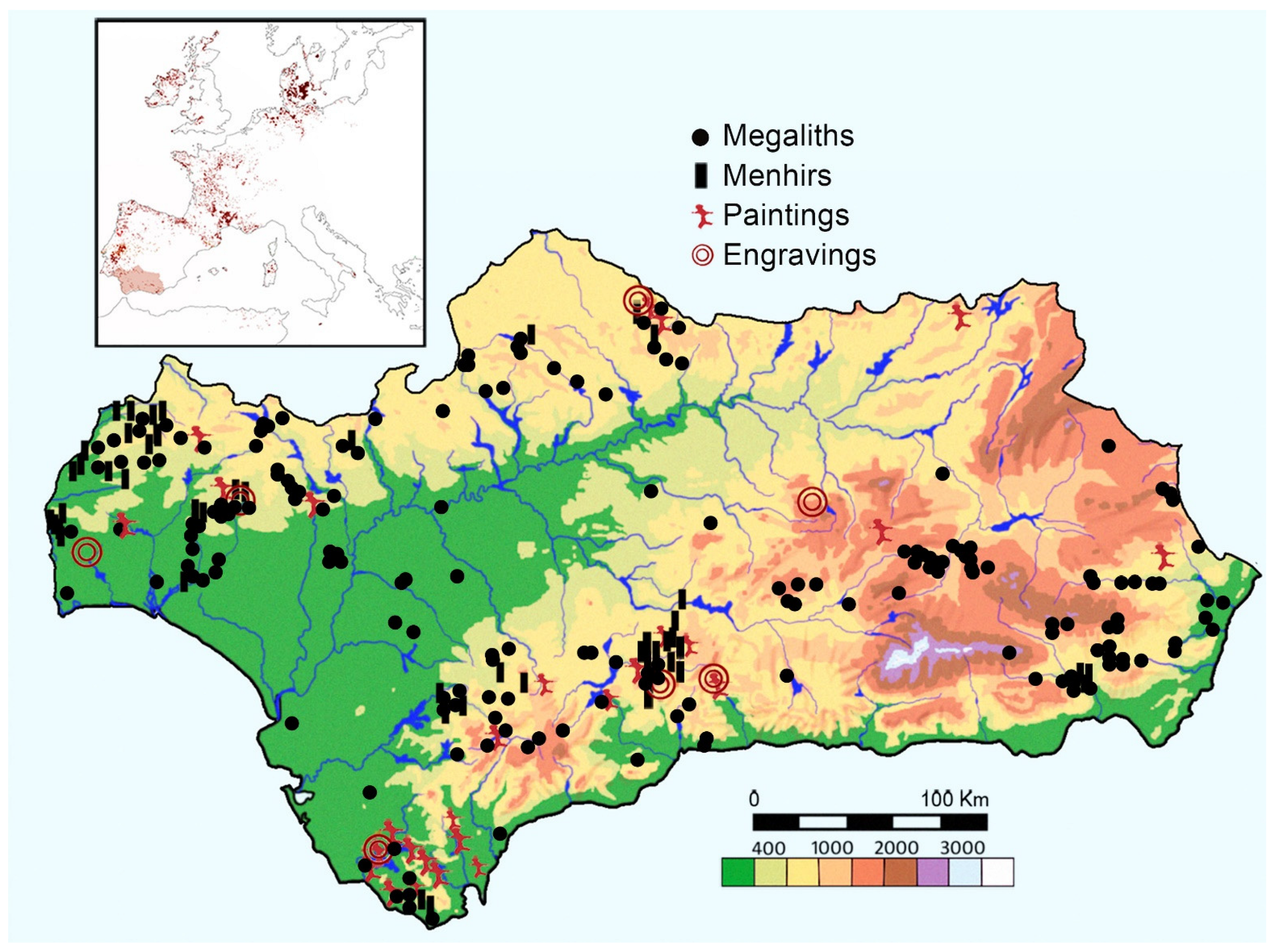
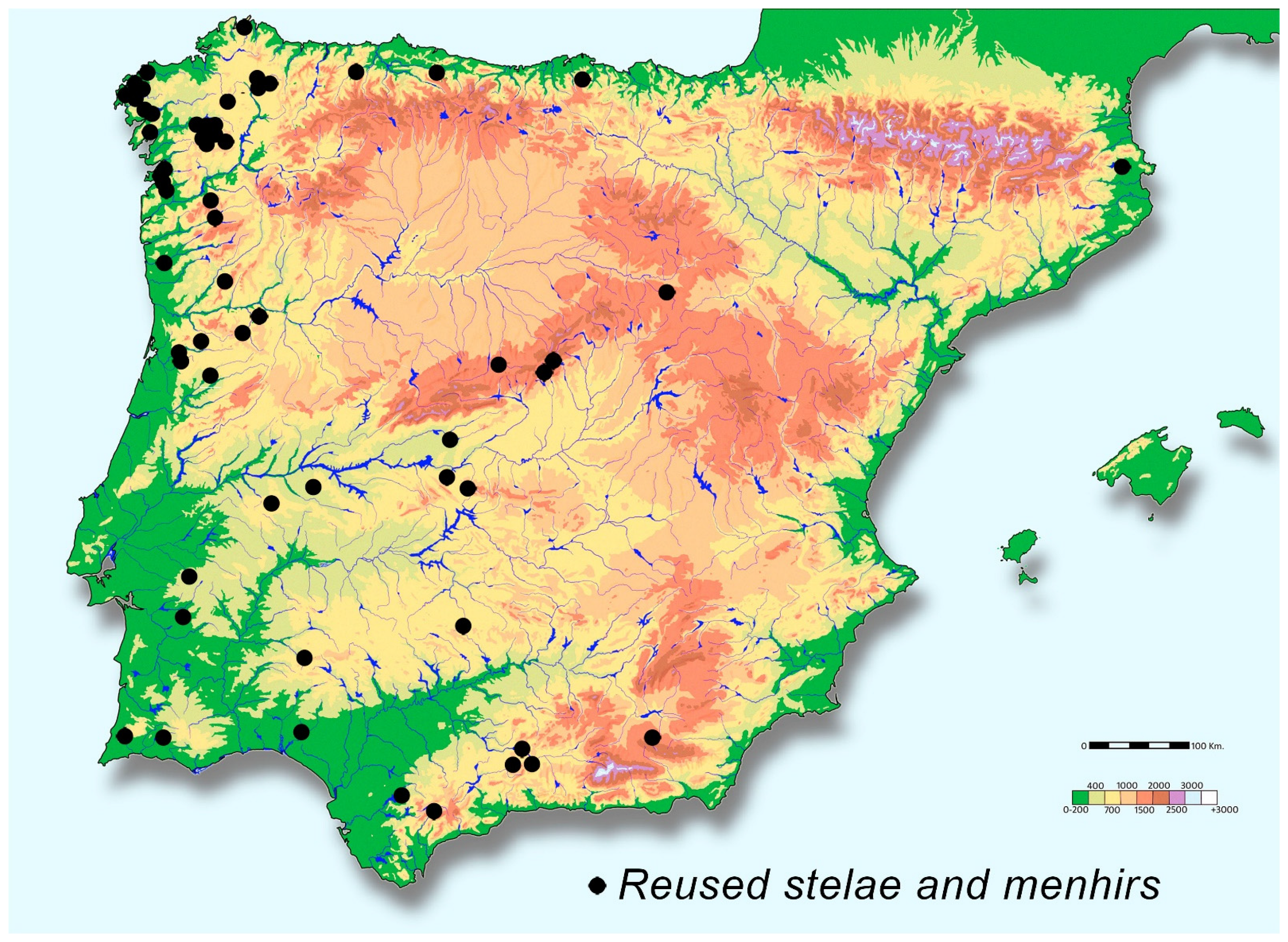
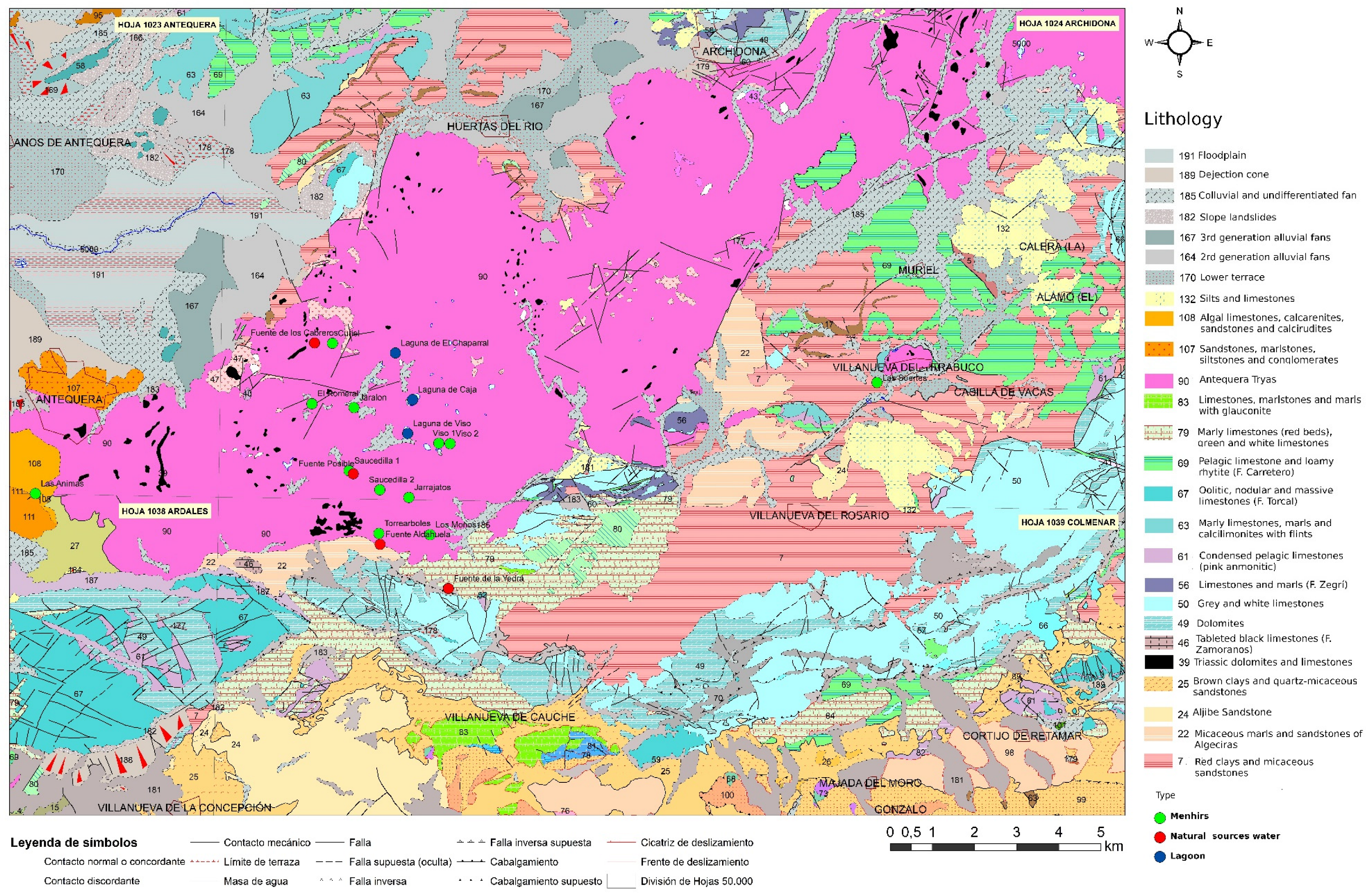
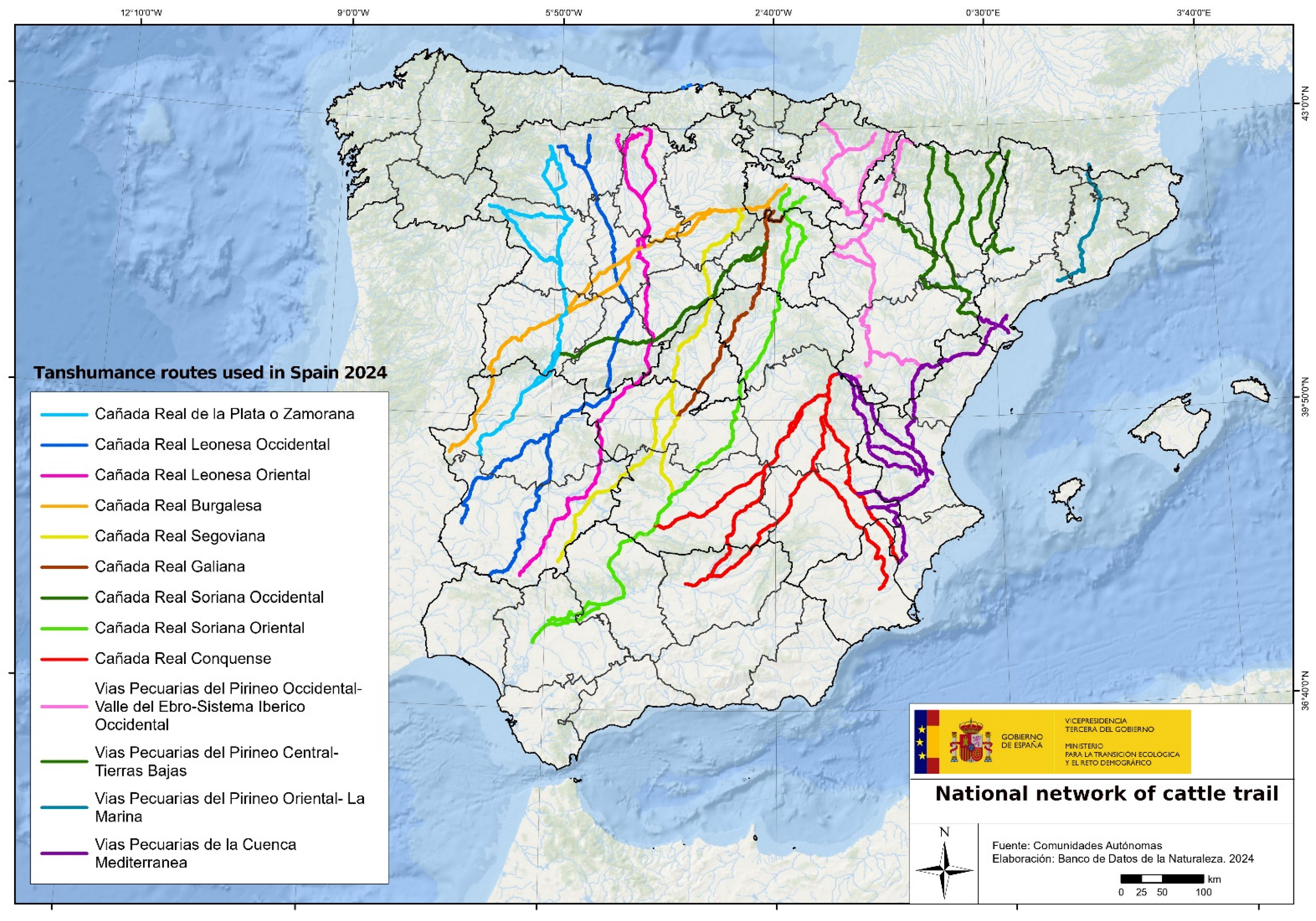
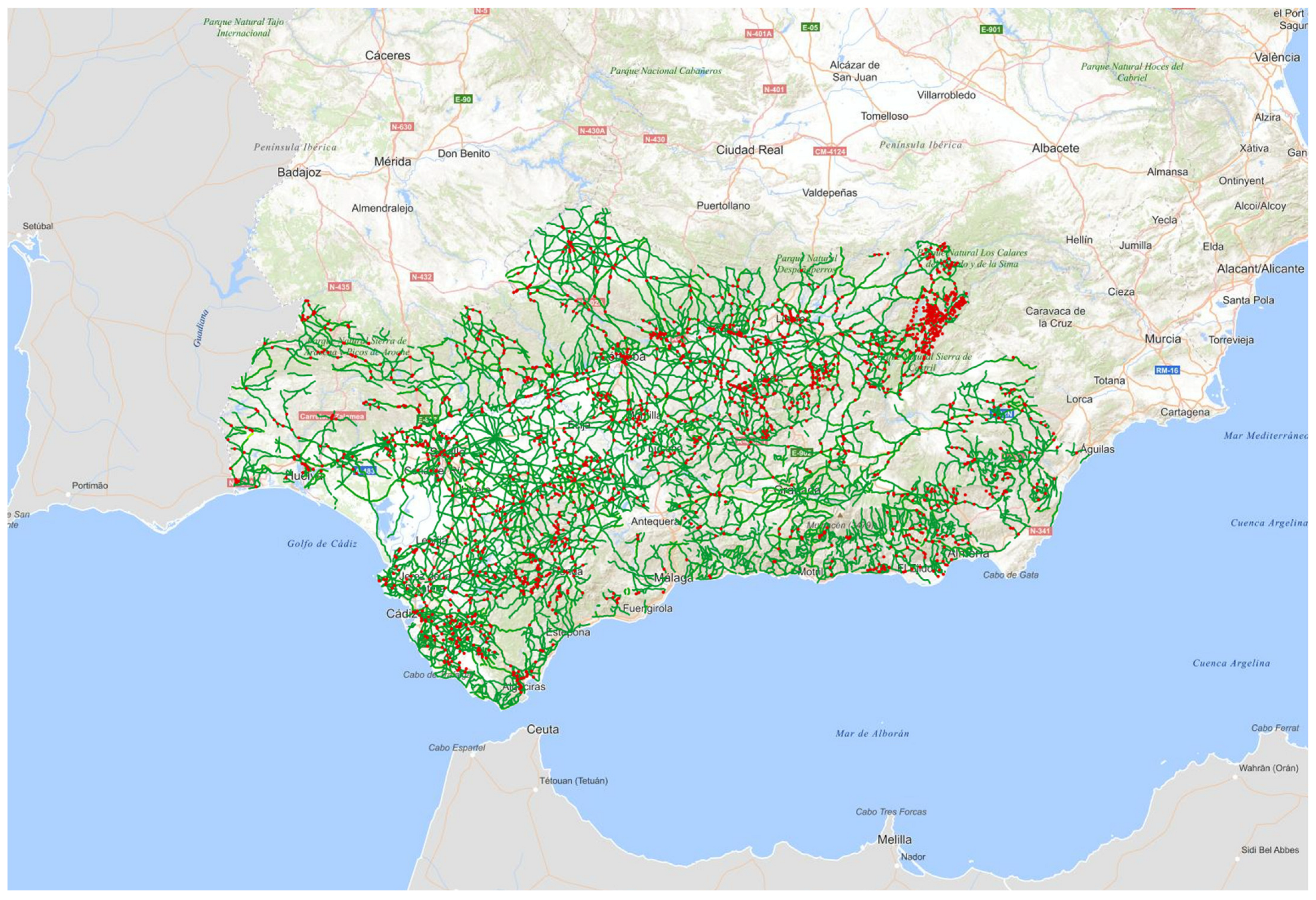
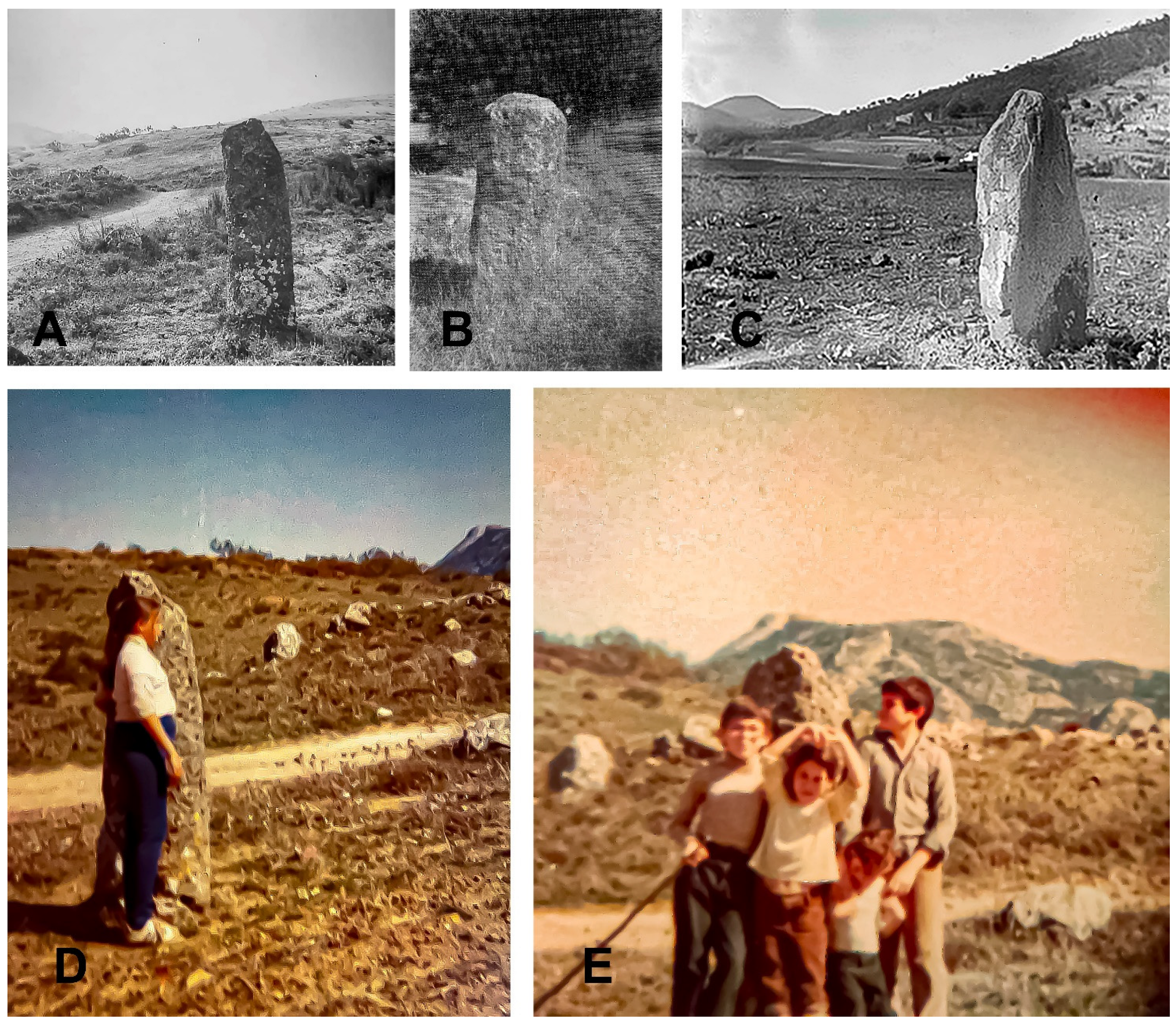
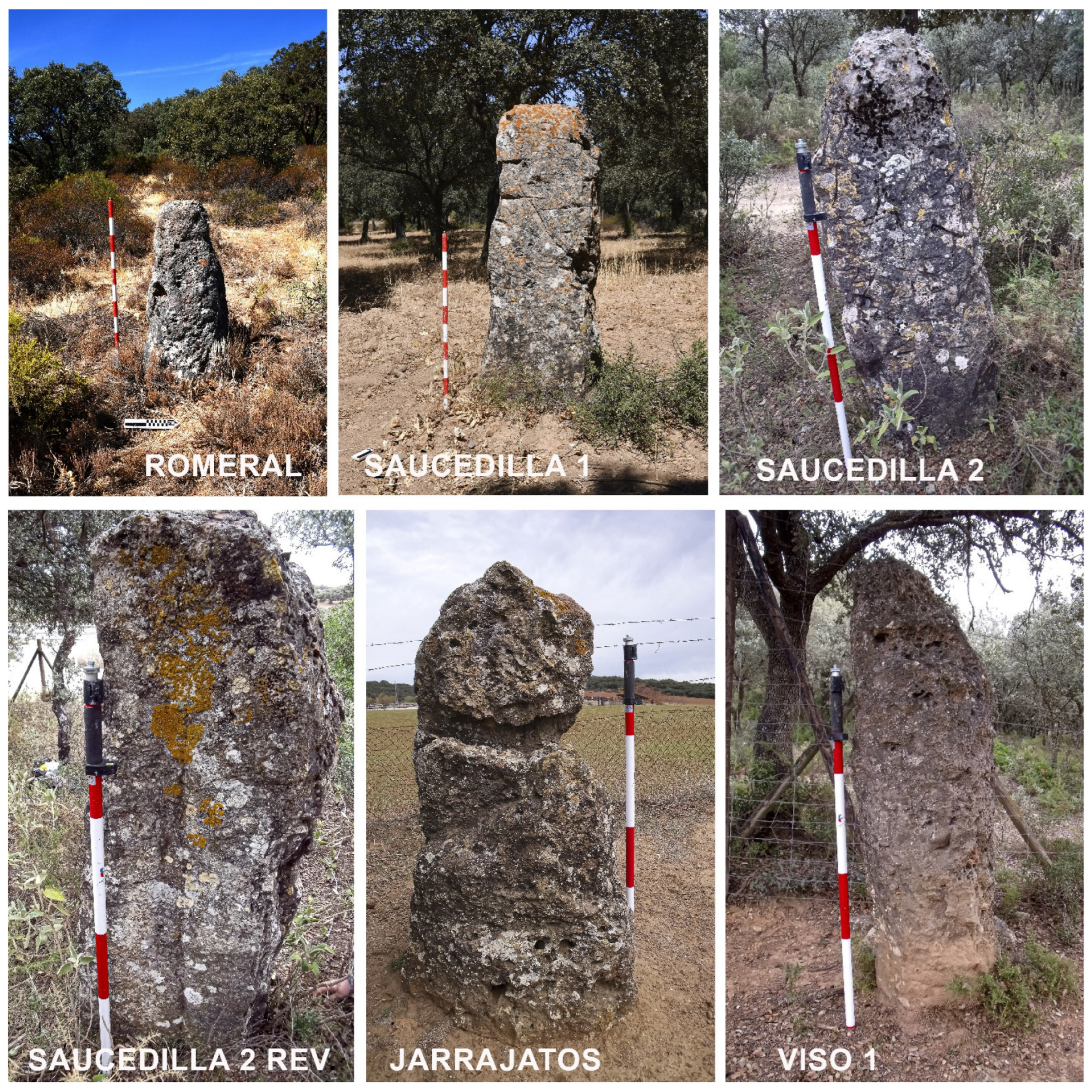
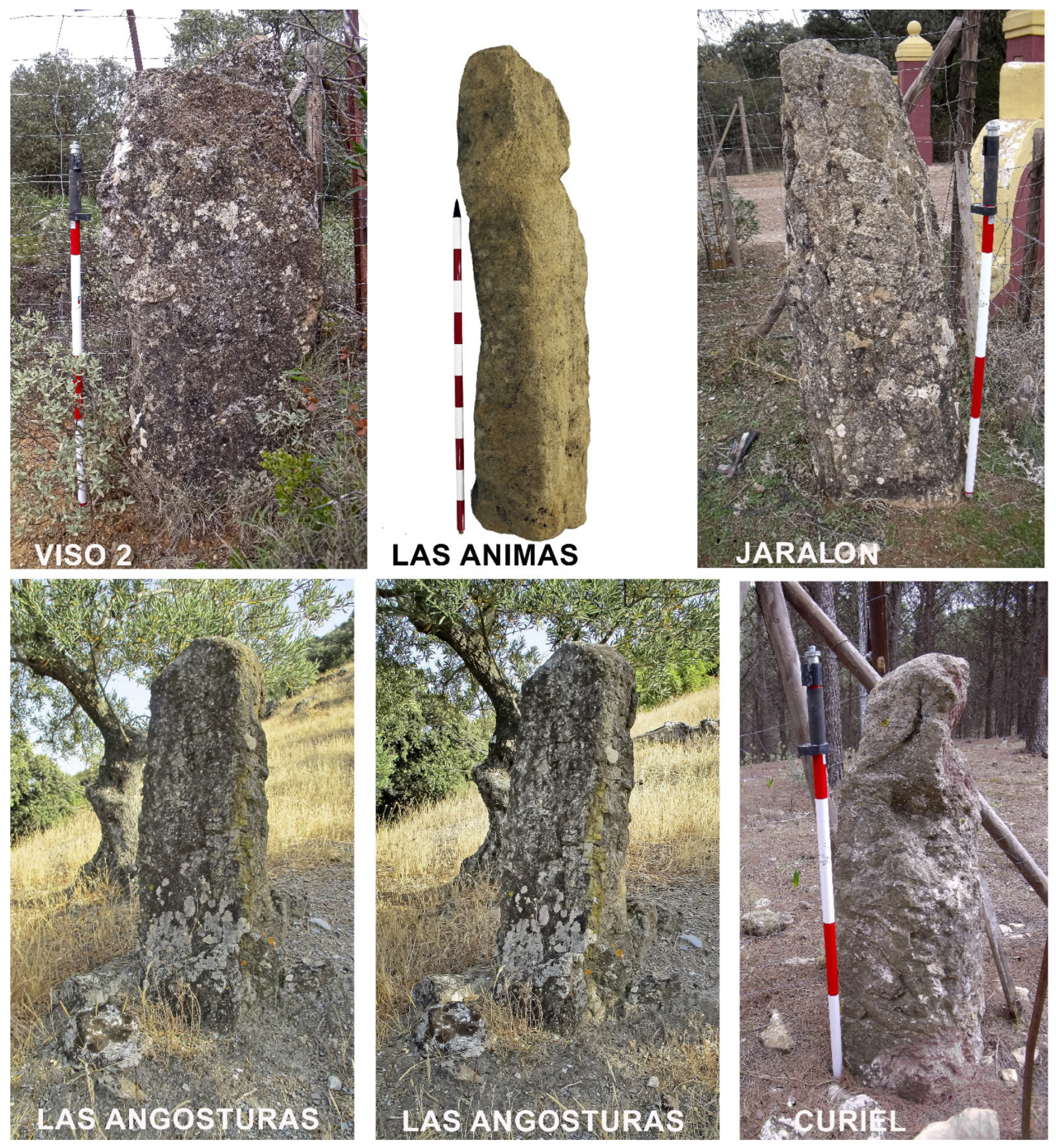
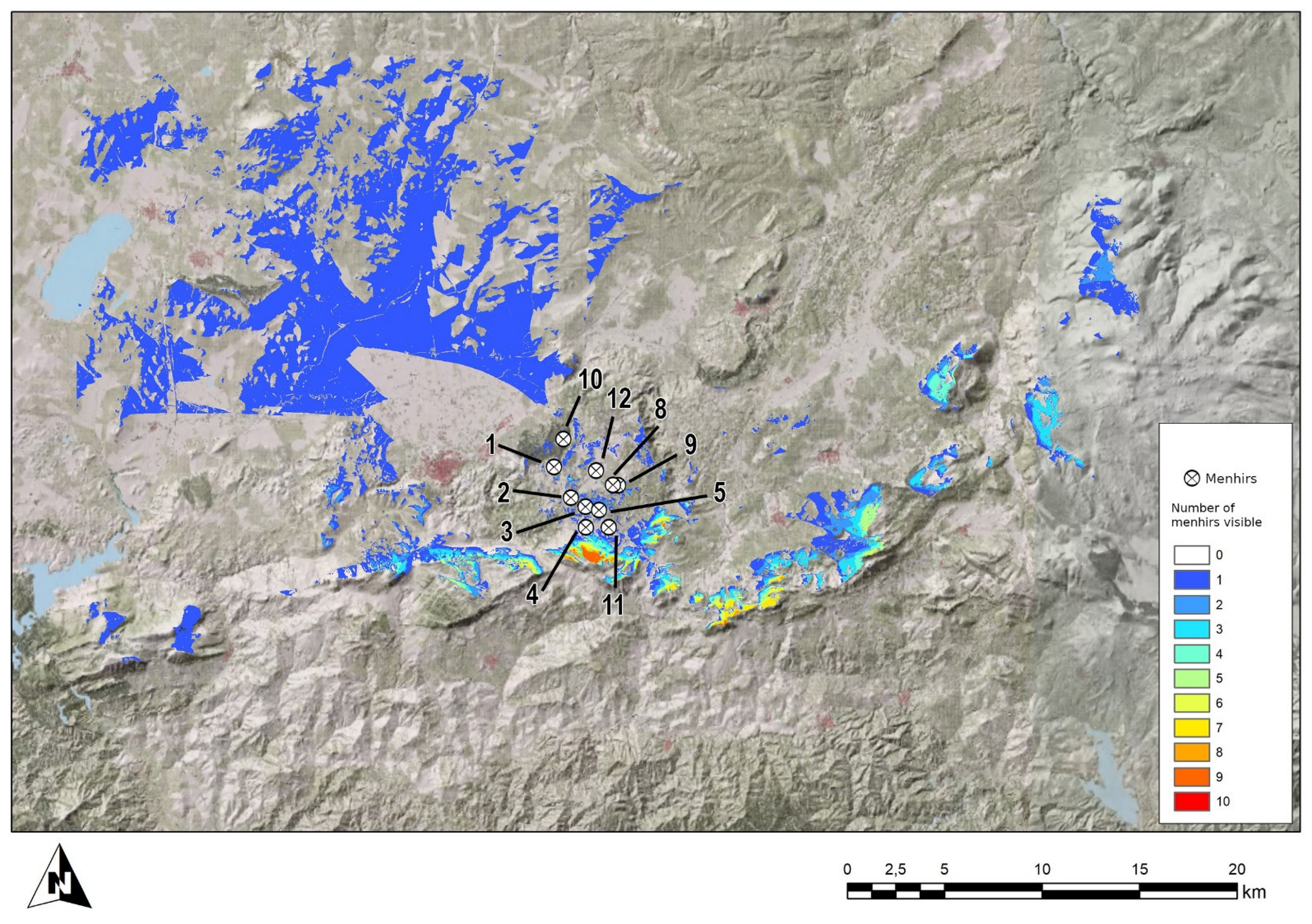
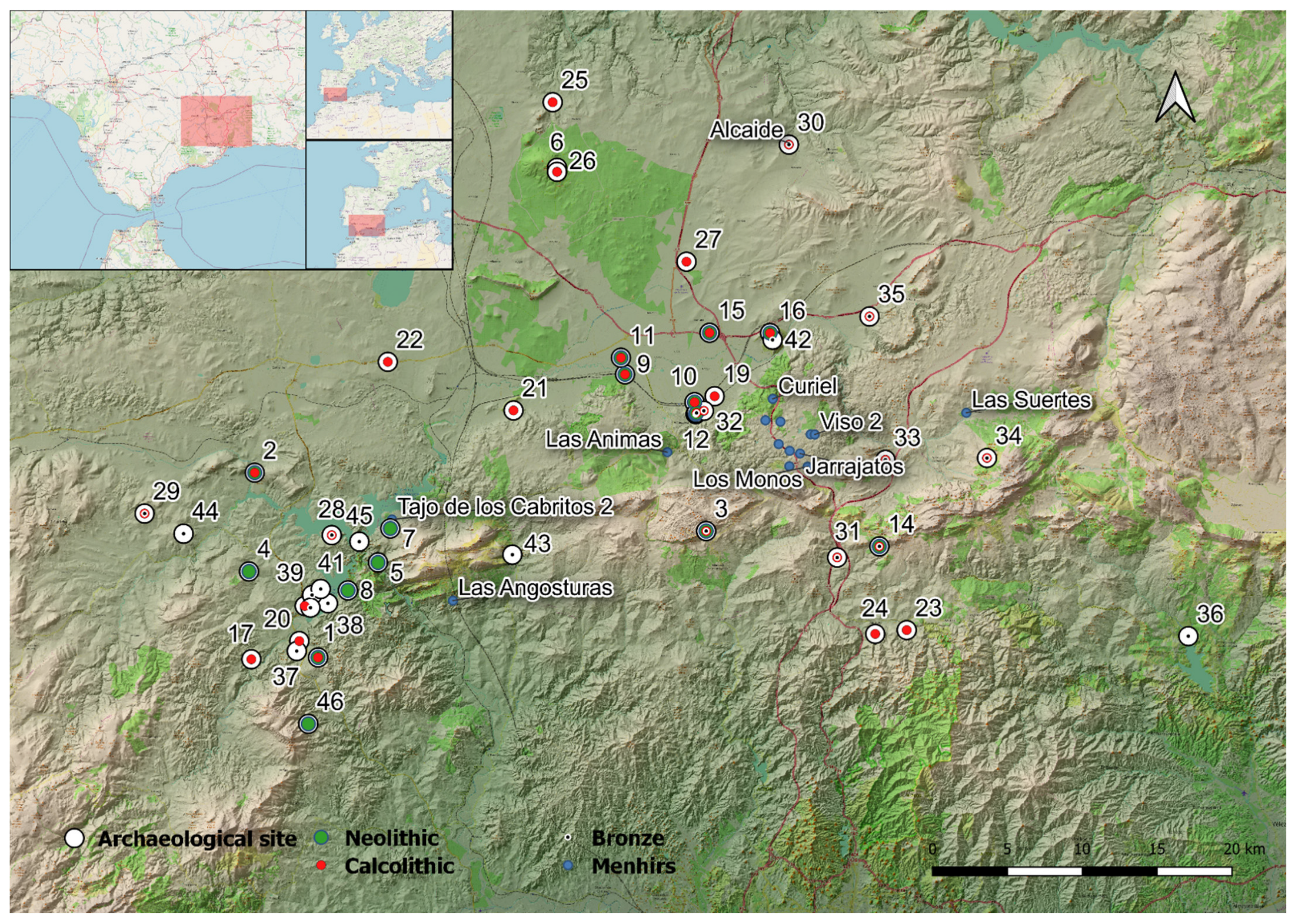
Disclaimer/Publisher’s Note: The statements, opinions and data contained in all publications are solely those of the individual author(s) and contributor(s) and not of MDPI and/or the editor(s). MDPI and/or the editor(s) disclaim responsibility for any injury to people or property resulting from any ideas, methods, instructions or products referred to in the content. |
© 2025 by the authors. Licensee MDPI, Basel, Switzerland. This article is an open access article distributed under the terms and conditions of the Creative Commons Attribution (CC BY) license (https://creativecommons.org/licenses/by/4.0/).
Share and Cite
Cabello-Ligero, L.; Bueno-Ramírez, P.; Armenteros-Lojo, M.J.; Suarez Padilla, J.; Caro Herrero, J.L.; de Balbín-Behrmann, R.; Barroso-Bermejo, R.; Vázquez Martínez, A.; Durán Valsero, J.J.; Durán-Laforet, S.R.; et al. The Menhir as an Oral Tradition in Cattle-Raising Territories: First Geological Provenance Analyses at the Antequera Heritage Site, Spain. Heritage 2025, 8, 291. https://doi.org/10.3390/heritage8080291
Cabello-Ligero L, Bueno-Ramírez P, Armenteros-Lojo MJ, Suarez Padilla J, Caro Herrero JL, de Balbín-Behrmann R, Barroso-Bermejo R, Vázquez Martínez A, Durán Valsero JJ, Durán-Laforet SR, et al. The Menhir as an Oral Tradition in Cattle-Raising Territories: First Geological Provenance Analyses at the Antequera Heritage Site, Spain. Heritage. 2025; 8(8):291. https://doi.org/10.3390/heritage8080291
Chicago/Turabian StyleCabello-Ligero, Lidia, Primitiva Bueno-Ramírez, María José Armenteros-Lojo, José Suarez Padilla, José L. Caro Herrero, Rodrigo de Balbín-Behrmann, Rosa Barroso-Bermejo, Alia Vázquez Martínez, Juan José Durán Valsero, Sergio Raúl Durán-Laforet, and et al. 2025. "The Menhir as an Oral Tradition in Cattle-Raising Territories: First Geological Provenance Analyses at the Antequera Heritage Site, Spain" Heritage 8, no. 8: 291. https://doi.org/10.3390/heritage8080291
APA StyleCabello-Ligero, L., Bueno-Ramírez, P., Armenteros-Lojo, M. J., Suarez Padilla, J., Caro Herrero, J. L., de Balbín-Behrmann, R., Barroso-Bermejo, R., Vázquez Martínez, A., Durán Valsero, J. J., Durán-Laforet, S. R., Jordá Bordehore, R., Morales García, R., & Varo Sánchez-Garrido, M. Á. (2025). The Menhir as an Oral Tradition in Cattle-Raising Territories: First Geological Provenance Analyses at the Antequera Heritage Site, Spain. Heritage, 8(8), 291. https://doi.org/10.3390/heritage8080291












